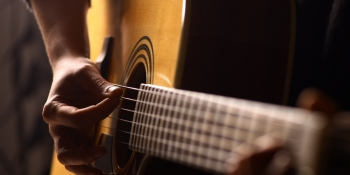
Beginner Bass lessons
The bass guitar is a stringed instrument and a member of the guitar family. In the construction of the body of the electric bass, its appearance is much similar to an electric guitar. However, the bass guitar has a longer neck and scale length as compared to a regular guitar and the fret spacing is also larger. This instrument has the lowest pitch amongst all the stringed instruments.
The electric bass evolved from the humble double bass (an acoustic upright bass), in the mid-1950s and typically had four strings at birth, but since, it has been evolving. In the modern times, it has come to range from four to six string courses and is still growing. At its core, much can be attained by a four stringed bass and it is a powerful instrument to learn to play.
The bass guitar is a plucked instrument, meaning that it is primarily played by alternating the fingers with an anchored or a floating thumb but there are no such restrictions as to how one likes to play or feel comfortable with an instrument. Hence, one can employ the thumbing or the picking techniques or even master all three!
The electric bass does not produce sound without external amplification. Therefore, it requires an amplifier for external amplification. One could choose between an active bass or a passive bass. The main difference is the sound that is produced by the two. A passive bass works well without 9V batteries and produces a consistent sound however it is not as punchy or bright. It is boomy and growly and preferred by my bassists. On the other hand an active bass requires a 9V battery to power up and it produces a punchy and brighter tone. This battery needs to be replaced from time to time as when the battery life is over, the bass starts to produce a dull to no sound, even with an amplifier.
A sturdy strap with a wider breadth that falls at a comfortable place along the neck and above the waist goes a long way!
In the Western tonal system, there are a total of 12 notes or pitches. Seven of these notes are named with the alphabets A-B-C-D-E-F-G. The rest of the notes are either a sharp or a flat of each of these alphabets, so we can say that some notes are either whole steps or a half step apart from each other.
The half step is the smallest distance between two notes (one fret on the bass) and a whole step has two half steps (two frets on the bass).
In this system of organising note names as alphabets we know that:
- Half steps fall between E-F and B-C.
- Whole steps fall between all the other sequential notes.
- Sharps make a note higher by a half step.
- Flats make a note lower by a half step.
- Natural signs undo a sharp and a flat.
Visualisation helps a lot of musicians. Therefore, sit in front of a bass and look at the length of the fretboard.
On a 24-fret four stringed bass there are about 40 unique pitches, but has 100 notes total (24 frets per string plus open notes).
Now that you know the notes of your instrument, it is important to build finger strength and mobility. So we will do finger exercises to enhance your reach and mobility over the fretboard and right hand exercises to learn the essential bass techniques that will help make your bass guitar sound the instrument it is.



 Version
2.0
Version
2.0